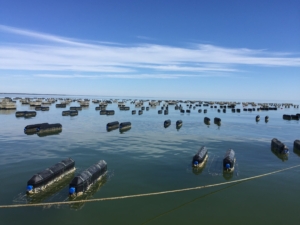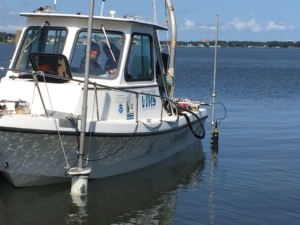Study from VIMS finds Minimal Water Quality Impacts from Oyster Aquaculture
Expanding oyster aquaculture operations in the Chesapeake Bay have raised concerns about the impacts of the industry to the watershed, from enriched sediment nutrients to viewshed concerns. Researchers from the Virginia Institute of Marine Science (VIMS), however, found that oyster farms in the lower Chesapeake Bay had little impact on water quality.

Floating oyster cages at the Windmill Point oyster farm near the mouth of the Rappahannock River. Cages are spaced relatively far apart, making the farm a low-density operation. (Photographer: Grace Massey)
Jessie Turner, a Ph.D. candidate at VIMS and the study’s lead author, worked with Lisa Kellogg, Grace Massey, and Carl Friedrichs, research scientists and professors at VIMS, and The Nature Conservancy to collect and analyze water quality data at the oyster aquaculture sites. The study was part of The Nature Conservancy’s larger Aquaculture By Design project in the Chesapeake Bay.
Collecting water quality data
During the summer of 2017, the team surveyed a total of four oyster aquaculture operations that spanned a variety of conditions and sizes: two sites that had more wave exposure and were naturally clearer and two sites that were upstream and more protected. Criss-crossing like a lawnmower between oyster cages, they towed sensors mounted to a VIMS research vessel to collect data, like turbidity, current spend, dissolved oxygen, and chlorophyll levels.

Instruments mounted to the vessel measured currents and water quality while researchers drove the boat slowly through each oyster farm and the area surrounding each farm. At the bow, an acoustic Doppler current profiler measured current speed and direction. Near the stern, a datasonde measured chlorophyll, turbidity, and dissolved oxygen. (Photographer: Grace Massey)
The four operating commercial farms differed in the type of gear used, spatial scales, and number of oysters produced. The study was focused on water quality within and outside of each farm. The team found minor differences in water quality inside and outside the farms, and it appears that the differences they observed were due to the site itself, rather than the oyster aquaculture operations.
“Even though they’re not having the [positive] impact we wanted, the oyster farms aren’t having a negative impact either and that’s important to note,” emphasized Turner. She also shared that the most striking result was that “with the biggest oyster farms, current speeds were slower inside the farm than outside the farm.”
Make room for more oyster aquaculture?
Turner explained that the lack of significant water quality impacts could be due to the low density of oysters in the farms and open areas where they were located. She said that the team’s findings suggest there is room for growth in oyster aquaculture in the Bay, “as long as the cages are well spaced.”
For future studies, Turner would like to compare their results with other farms around the Bay. She also shared that, “even though we didn’t find any effects in water quality, we know oysters take up nitrogen and phosphorus through feeding and growth, so over time we would expect harvesting of farmed oysters to be beneficial to the Bay.”
